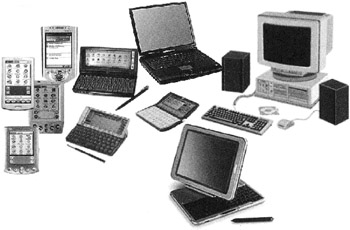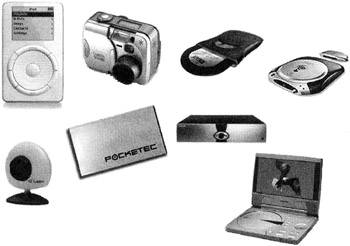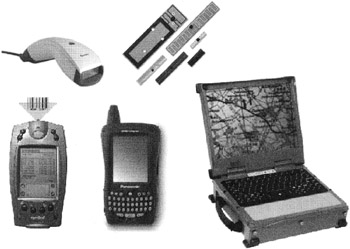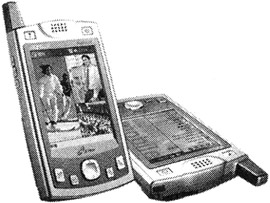Chapter 20: Client Devices
|
| < Day Day Up > |
|
Overview
These are the most visible components of a wireless network—the physical platform for wireless applications that provide services such as data capture and display, information processing, location detection, and even voice communications. These devices may be carried by end-users, mounted within shipping containers, or installed inside a vehicle.
The purpose of any network, whether wired or wireless, is to exchange information and share resources beyond one device. In general, the types of devices found using (not comprising) a wireless network may include some or all of the following:
-
Personal computers (PCs).
-
Laptop/notebook computers.
-
Personal digital assistants (PDAs).
-
Tablet computers.

Figure 20.1: Some of the client computing devices that most commonly access the typical corporate WLAN. -
Information storage devices—CD-ROMs, DVDs, Zip Drives, portable hard drives, etc.

Figure 20.2: Storage devices and more. This graphic depicts from left to right the Apple iPod MP3 player, Canon digital camera, Zip drive, HP CD Player, Labtec Web cam, Pocketec portable hard drive, Phillips Tivo device, and Toshiba's portable DVD player.
Figure 20.3: Printing wirelessly. This graphic depicts from left to right the HP Jetdirect 380x 802.11b wireless external print server, Zebra QL 320 direct thermal mobile printer, Epson Stylus C8OWN printer, Netgear PS111W 802.11b Wireless Ready Print Server, and the Buffalo AirStationTM Ethernet Converter (WLI-T1-S11G), which allows you to connect a network-ready Brother Printer/MFC to a Wi-Fi network in ad-hoc or infrastructure mode. Print servers help small workgroups to easily share a broad range of network-capable printers and multi-function peripherals across wireless networks. -
Printers—any device that makes an impression on media, usually paper, and is connected to a computer (wired or wirelessly). These devices range from a simple printer in a cash register to advanced printers that are capable of magazine quality photo images. The printers most often found in a corporate environment include inkjet, laser, and the new LED (Light Emitting Diodes) printers.
-
Scanners—these devices come in many different forms, including hand-held, feed-in, and flatbed types; some can scan black-and-white only, others can also scan color. Very high-resolution scanners are used for scanning photos and graphics for high-resolution printing. Lower resolution scanners are just fine for the average corporate office's scanning needs.
-
Devices for the vertical market. These include ruggedized computers (used in field, warehouse and service operations, barcode readers (commonly used in the transportation, warehousing and distribution industries), RF tags (used to identify and track goods and equipment—most commonly used in the transportation, warehousing and distribution industries, but large organizations may use RF tags to keep track of its hardware and equipment assets), and handheld PCs (devices that are normally a little larger than the palm-sized PDAs, use the Windows CE operating system, have a form factor that is more rugged than the typical PDA, need a larger battery than the typical PDA, are used with work-related applications like inventory management systems, are not pre-loaded with personal organization software, and offer specialized keys or touch-screens for easy input of regularized form-information).

Figure 20.4: This graphic depicts from left to right the C-Pen 800C Handheld Scanner (can scan directly into a cursor position on a PC), Konica Film Scanner for Professional RX-3, Trust SCSI Connect 19200 high resolution scanner (good for scanning graphics), and HP 3500c Scanjet color scanner.
Figure 20.5: This graphic depicts from left to right Intermec ScanPlus 1800 (barcode reader), passive RF tags that require no battery and are inexpensive and long lasting, Symbol Technologies SPT1700 handheld computer with barcode scanner, Panasonic Toughbook 01 ruggedized handheld computer, and Miltope TSC-750 ruggedized computer. -
Smartphones—a combination PDA and mobile phone offering wireless Internet access as well as voice communications.
-
Wi-Fi phones.

Figure 20.6: This graphic shows an Eten Smartphone P600. These devices can serve dual duty as both wireless phone and PDA.
|
| < Day Day Up > |
|
EAN: 2147483647
Pages: 273